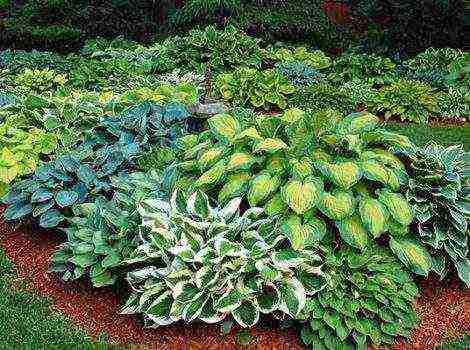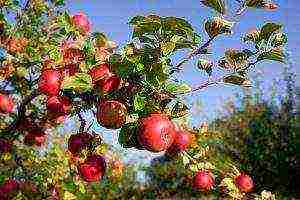Content [show]
Tomatoes are unpretentious plants that are easy to care for, but in order not to get small or diseased fruits, you will need to pay a little attention to the culture. The plant responds very well to regular watering and feeding, rewarding gardeners with a generous harvest. In this review, we will talk about the proper care of tomatoes after planting in open ground.
Stages of caring for tomatoes after planting in the ground
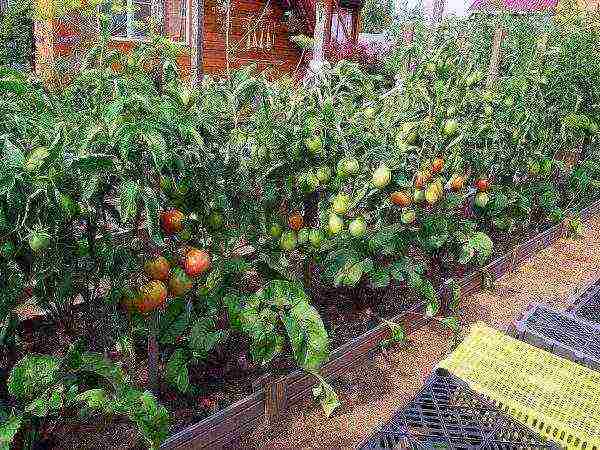 Only with proper and timely care can you get a good harvest of tomatoes.
Only with proper and timely care can you get a good harvest of tomatoes.
After choosing a variety and planting seedlings in a tomato garden, it is necessary to provide timely care, which consists in supplying the plant with nutrients and moisture. In addition to basic needs, there are others that have no less influence on the growing season. The intricacies of the work can be found in this article.
Proper watering
Tomatoes react in the same way to a lack and excess of moisture, so irrigation is carried out as the soil dries up. Before flowering, the frequency is 1 time per week, during the formation of fruits, watering is increased up to 2-3 times a week. In hot weather with high daytime temperatures, you will need to water the soil every other day or even daily (focus on the degree of dryness of the soil). The procedures should be carried out only in the early morning or late evening. Evening is preferable, since moisture will remain in the ground longer, which means that the plant will be more comfortable.
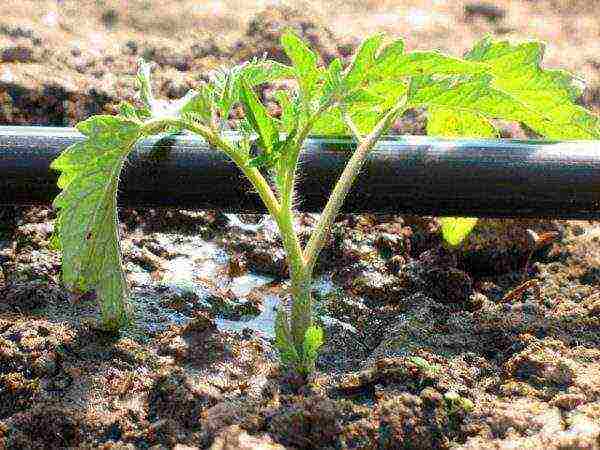 The drip irrigation system is used not only for irrigation, but also for organic fertilization of tomatoes.
The drip irrigation system is used not only for irrigation, but also for organic fertilization of tomatoes.
When equipping an irrigation system, preference should be given drip or underground version... Sprinkling moisturizes the tops, while increasing the risk of developing fungal diseases, in particular top rot. Irrigation can also be carried out at the root or along the grooves. For the prevention of diseases, it is recommended to add wood ash to the settled water. And when ovaries appear, ash powder is sprinkled around the bushes for better fruiting.
It is not recommended to use tap water for humidification. A settled and warmed-up well option is more suitable. The liquid rate per bush is 8-10 liters.
Periodically, watering is combined with the introduction of foliar dressings. For this, mineral fertilizers are dissolved in the water used for irrigation. Thus, the time for both procedures is reduced.
Grassing tomatoes
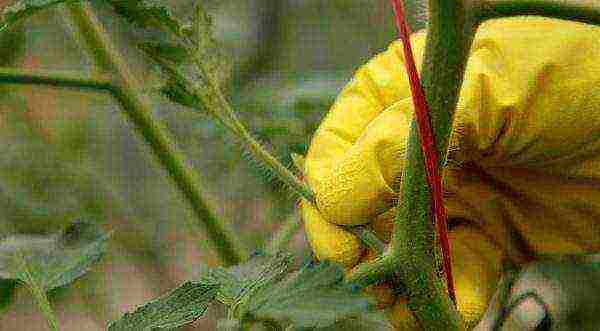 If you do not remove the stepchildren of tomatoes, they will powerfully develop, and the plant will turn into a multi-stem bush with numerous flowers.
If you do not remove the stepchildren of tomatoes, they will powerfully develop, and the plant will turn into a multi-stem bush with numerous flowers.
Some gardeners underestimate the procedure for pinching tomatoes, believing that a branchy bush and a large number of shoots increase yields. Actually the plant does not have enough strength for all the ovaries, therefore, the fruits are often formed small or simply do not have time to ripen. The issue is solved by removing useless shoots. This should be done while they are still small (3-5 cm). If time is lost, and they have already gained growth, then it makes no sense to carry out pinching.
The procedure is carried out in early August. All stepchildren are removed from the bush, leaving 2-3 leaves above the fruits. Sometimes it becomes a pity to pick off the inflorescences, but this will be for the good of the ripening fruits (they will be much larger).
Another method of pinching involves removing excess shoots every 10 days. In this case, one of the options for the formation of a bush is selected: in one stem, in two or three. The choice is based on the variety.
Spraying against pests and feeding
The beds with tomatoes should be sprayed not only after the detection of insects, but also for prevention, since among the nightshade crops, tomatoes are the most vulnerable. How to spray you ask?
At the stage of planting, the roots of the seedlings are soaked in a solution of insecticides (for example, Aktara) to protect against wireworms, May beetles and aphids. Before the fruiting period, the beds are periodically treated with fungicidal preparations (Quadris, Ridomil Gold), which prevent the development of fungal diseases.
You can use folk remedies. Spraying the bushes with infusions of onion husks, wood ash, and garlic are considered quite effective. To scare away insects, decoctions from fragrant plants are suitable: pharmacy chamomile, wormwood, calendula, etc.
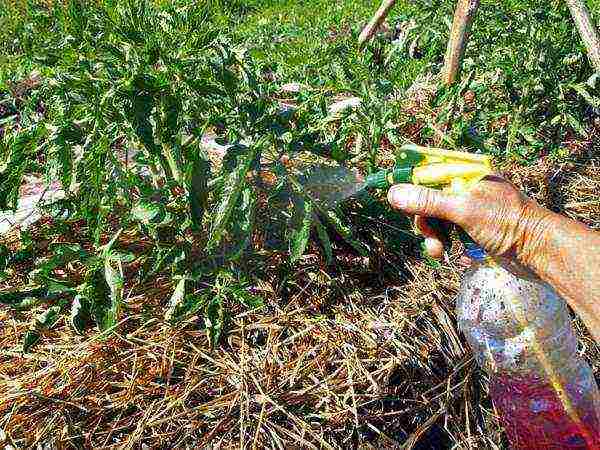 Tomatoes are sprayed at the very beginning of flowering, as well as with the appearance of ovaries
Tomatoes are sprayed at the very beginning of flowering, as well as with the appearance of ovaries
You need to feed tomatoes at least three times during the growing season. On nutrient-poor soils, this is done systematically every 2 weeks. Fertilizers are used both organic and mineral. The nitrogen content in them should be less than potassium and phosphorus. How much fertilizer should be added for processing?One of the options provides for the following composition:
- 50-60 gr. superphosphate;
- 30-40 gr. potassium chloride;
- 15 gr. ammonium nitrate;
- 10 liters of water.
If shedding of inflorescences and ovaries is observed, the plant lacks trace elements (boron). You can prepare a solution from boric acid (1 g) and water (1 L). Spray greens in the afternoon.
The culture responds well to poultry manure solution. It is preferable to use complex fertilizers that contain trace elements such as magnesium, boron, copper, zinc. Popular remedies include: Master NPK-17.6.18, Kristallon et al.
Hilling and loosening
After each watering, it is advisable to slightly loosen the soil (immersion depth is about 3 cm). This helps to retain moisture in the soil, opens up access to oxygen. The first loosening can be done after the first irrigation of the seedlings. The regularity of the procedures is 1 time in 10-14 days. When the bushes grow and the aisles narrow, the loosening can be stopped.
It is rational to combine the process of loosening with weeding. Weeds attract pests, create shading for tomatoes, so the fight against them is a priority.
To stimulate the formation of additional adventitious roots, it is recommended to hilling tomato bushes. They form from the bottom of the stem, but only in moist soil. Raking the soil under the plant should be several times per season. The first procedure is carried out 2-3 weeks after planting the seedlings. The second time hilling in the beds is performed after 2 weeks. In order not to injure the tomatoes once again, the event is combined with loosening and weeding.
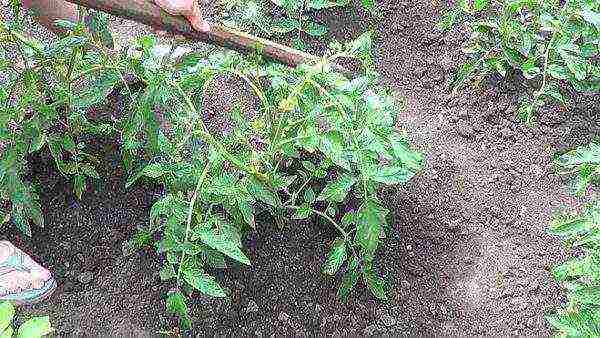 With the help of hilling, you can achieve the appearance of additional roots on the bush
With the help of hilling, you can achieve the appearance of additional roots on the bush
Forming tomato bushes and breaking leaves
It is necessary to form bushes only in those plants that are prone to branching. If the variety is characterized by the development of one stem, then there is no need for the procedure.
There are several ways to form bushes:
- in one stem;
- in two stems;
- in three stems.
When deciding on an option, it is worth considering the characteristics of the variety and the climatic conditions of the region. The further south the area, the more branches you can leave on the tomato. It is important to take into account that fruits that do not form on the main stem will be smaller.
When choosing the one-stem method all stepchildren who have reached a length of 3-5 cm are subject to removal.To prevent the tomato from dropping all the flowers and ovaries, it is recommended to first cut off the shoots that have grown under the brushes.
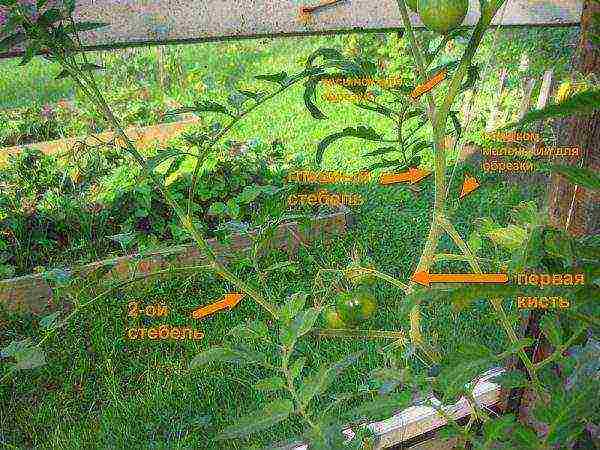 Formation of a tomato bush into two stems
Formation of a tomato bush into two stems
If the tomato is formed into two stalks, then you need to leave the lateral shoot, which formed near the first brush. And when choosing the third method, it is recommended to leave the strongest stepson developing under the second hand.
You need to remove excess shoots regularly, the only limitation to the procedure is heat. In such conditions, the plant does not tolerate any injury.
Tear off the sprouts very carefully, grasping them with your thumb and forefinger. You need to pull not towards yourself, but sharply to the side. You can also use a knife with a sharp blade. When cutting the stepson, do not touch the main stem, it is better to leave 1-2 mm of the shoot to be removed.
Soil mulching
Backfilling the soil with mulch makes it possible to reduce the number of watering, weeding and loosening. Such savings are simply necessary for summer residents visiting the plots exclusively on weekends. In addition to reducing the labor intensity of the process, protection of the soil from drying out is created.
The feasibility of mulching can be assessed based on the following advantages:
- decline weed growth (reduction in the number of weeding);
- stabilization temperature regime and soil moisture;
- defence from evaporation of moisture;
- prevention crust formation on the surface of the ground;
- earthworms they are better bred under a kind of fur coat, which increases the looseness of the soil.
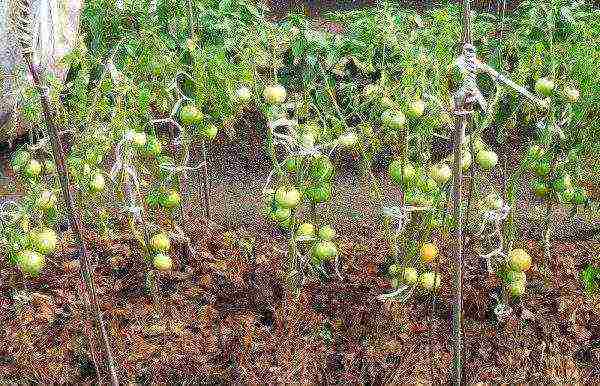 To reduce the number of watering and accelerate the ripening of fruits, tomatoes are mulched
To reduce the number of watering and accelerate the ripening of fruits, tomatoes are mulched
Peat, dry leaves or straw, sawdust are used as mulch. Rotted compost is also good. In the garden departments of hypermarkets today you can buy artificial mulch, which is reusable. The layer to be laid should be about 6-8 cm, so that light passes faintly through it. This will prevent overgrowth of weeds.
Surrounding the tomato garden with attention, it is worth observing the measure when watering and fertilizing, otherwise you can get the opposite effect. Experienced gardeners determine the needs of plants by their appearance, therefore 2-3 times a week you just need to inspect the bushes. Then any identified problem will be easier to localize or eliminate.
We continue the conversation about growing tomatoes in the open field. We have already talked about planting tomato seedlings in open ground, and now let's talk about the basic principles of caring for tomatoes that will allow you to get a good harvest.
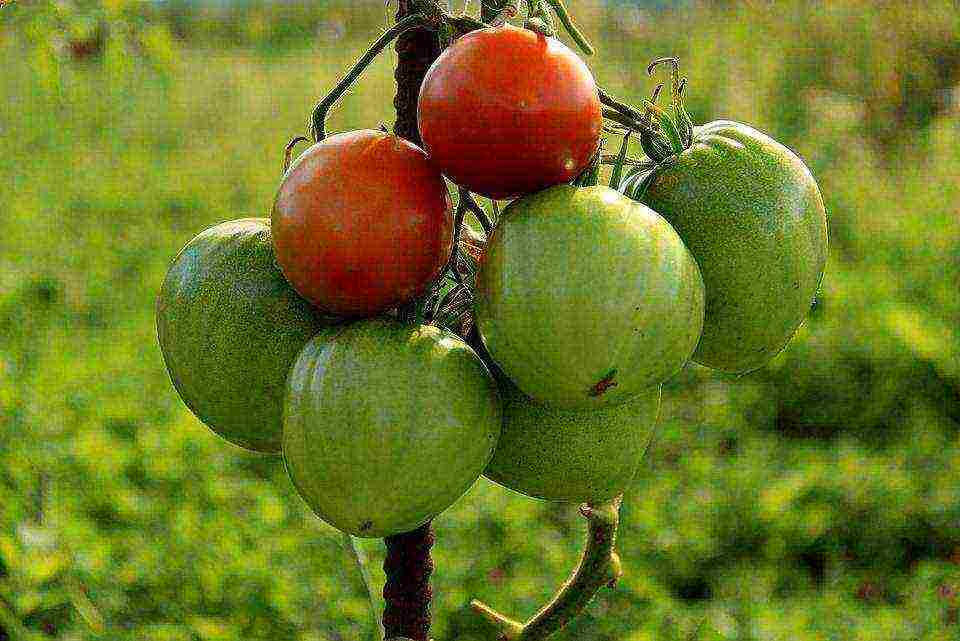
Unfortunately, you can't just stick the plant into the ground, and after a couple of months come for the harvest. If something grows with such an attitude, then it will not be much. To harvest a decent crop of tomatoes, after planting seedlings in open ground and before harvesting, a number of measures are needed:
Tomato care activities
- frost protection
- regular watering
- feeding
- tillage:
- loosening
- weeding
- mulching
- hilling - protection from disease
- tying up
- plant formation
- removal of leaves
- pinching
- thinning of ovaries
- pinching
Frost protection
If you plant seedlings in the ground early, you can get an earlier harvest and increase the fruiting period. However, there is a risk of death of the planted plants from frost. In most cases, tomatoes die at temperatures from +2 to –1˚С.
It is most effective to make a general film cover for the entire garden. To do this, it is convenient to dig in wire arcs, on which the film is stretched during a cold snap. If the temperature does not rise above 15˚С during the day, the film can be left on.
You can make individual shelters-caps from paper, fabric, film, boxes - any material that can be used to cover a tomato bush, creating your own microclimate under it.
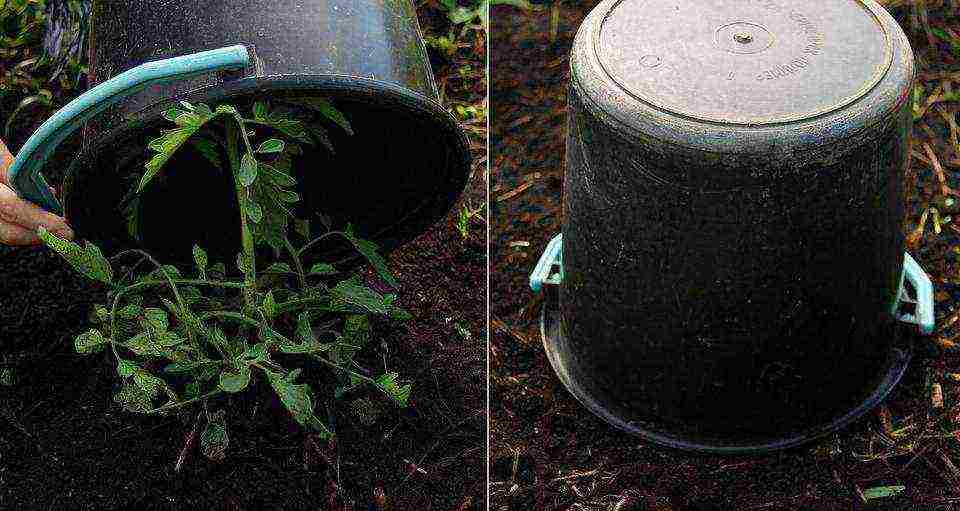
We cover the bush with a bucket
Low-growing seedlings can be covered with soil before the onset of frost and dug out after the frost has passed. Try to cover the entire plant with earth. If the tops do freeze, stepchildren will grow from the preserved lateral buds, from which you can get a good harvest.
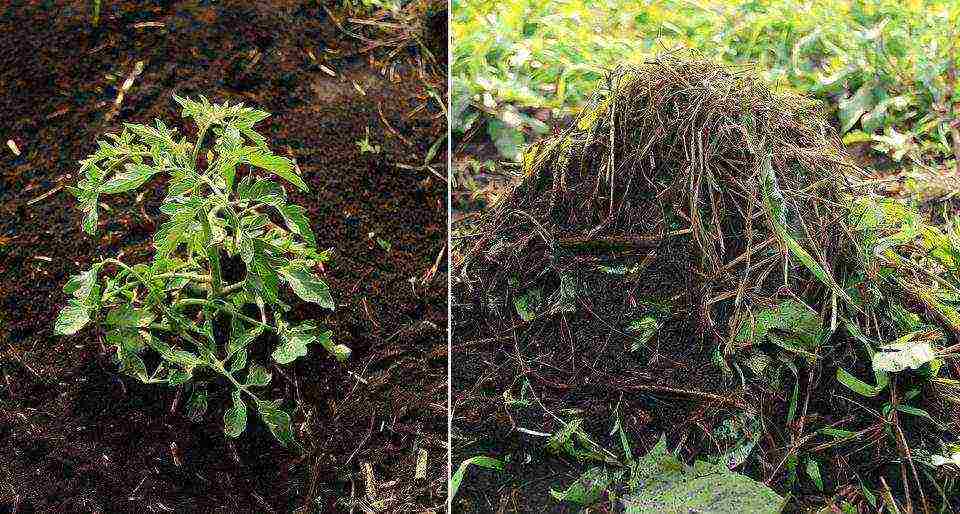
We bury the bush
Watering
Tomatoes need rare but abundant watering. Frequent watering in small portions is harmful, however, as well as excessive ones. Lack of moisture leads to damage to the fruit with apical rot, excess creates favorable conditions for gray rot and phytophthora.
Tomatoes love dry tops, so watering is done only at the root. When watering by sprinkling (from a watering can, from a hose with a sprinkler), the temperature of the soil and air drops sharply, which has a bad effect on flowering, increases the shedding of flowers, delays the setting and ripening of fruits. In addition, air humidity rises, which contributes to the spread of fungal diseases.
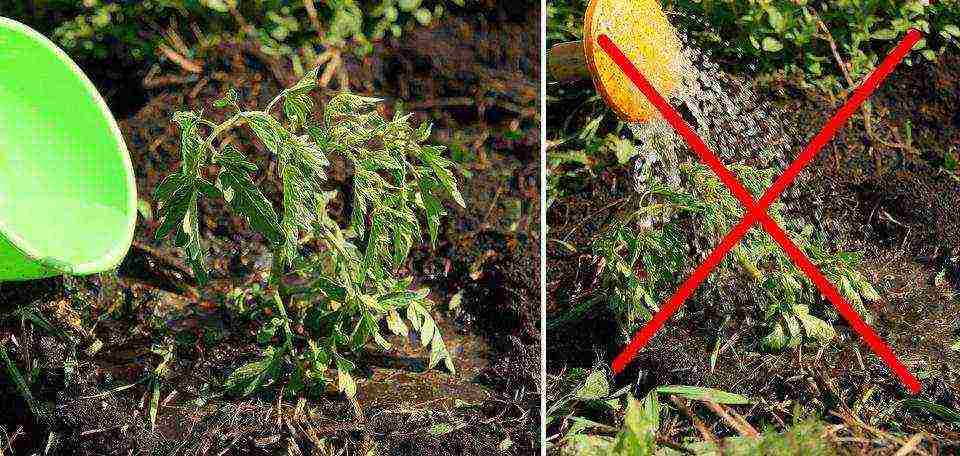
Watering at the root
The need for watering can be determined by the appearance of the leaves. With a lack of moisture, they darken and wither in the heat.
The first 10-15 days after planting the seedlings, the plants can be left without watering. The water poured into the hole during planting should be enough for rooting and growth.
When the active growth of plants begins and ovaries appear, the need for water increases sharply. If there is no rain during this period, watering is carried out every 5-7 days, pouring 3-5 liters of water into each hole.
During the period of fruit growth, the soil must be constantly moistened (this can be achieved by mulching). Sharp changes in soil moisture cause a halt in the growth of green fruits and cracking of ripe ones.
When the ripening of fruits begins, watering of early ripening low-growing varieties is reduced, and tall varieties, on the contrary, increase.
Top dressing
Usually, the first feeding is done about 10 days after planting the seedlings in the ground. 5-6 g of urea, 20-25 g of double superphosphate, 6-10 g of potassium salt or a similar amount of other nitrogen, phosphorus and potassium fertilizers are applied per square meter.
Further feeding is carried out every 7-15 days, depending on what is fed and on the condition of the plants. With a lack of nitrogen, plant growth stops, the leaves and stems have a pale green color, then the leaves turn yellow and fall off, starting from the bottom of the stem. With a lack of phosphorus, plants poorly assimilate nitrogen, which leads to a cessation of growth. The stem and petioles acquire a bluish color, later the leaves turn gray. With a lack of potassium, small yellow-brown spots are formed at the edges of the leaves, the edges of the leaves are curled, brown spots appear on the fruits.
At the beginning of growth, it is better to use liquid organic fertilizers - a solution of cow manure or poultry manure, 0.6-0.8 liters per plant.
The development of tomatoes is well influenced by feeding with herb infusion. Grass is placed in a barrel (plastic or well-painted metal), filled with water and closed loosely with a lid. After two weeks, the infusion is diluted with water in a ratio of 1:10 and used for irrigation (3-5 liters per plant). The best infusion is obtained from nettle, but you can use any herb, including with seeds - the seeds die from long soaking and fermentation. Such fertilizer has a great advantage - you do not need to buy it, you do not need to go anywhere for it, usually there is a lot of grass both on the site itself and next to it. With good soil fertility, you can not use either mineral fertilizers or manure - an infusion of grass will be enough. Watering with infusion is done every 7-14 days, depending on the state of the plants. It is impossible to water with undiluted infusion, so as not to "burn" the roots and soil with nitrogen.
When choosing a place for a barrel, keep in mind that a very unpleasant odor is emitted when the grass ferments. Therefore, it is better to place such a barrel in a remote corner of the site.
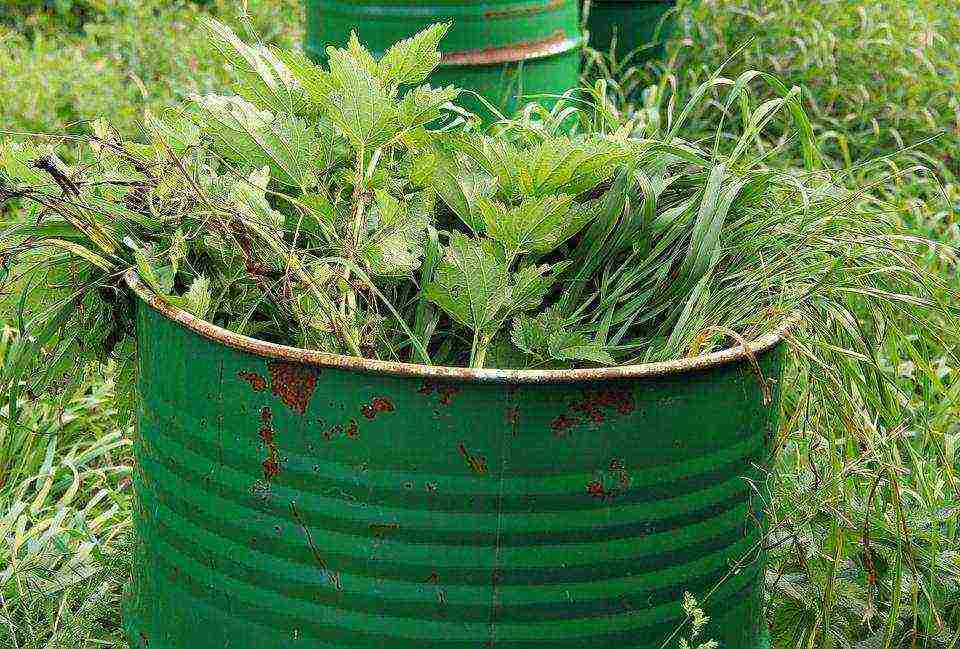
Loading the barrel with grass
In addition to the usual one, foliar feeding can be carried out (as an addition to the main food, but not as a substitute for it). For this, readily soluble fertilizers are used, for example, for 10 liters of water, 16 g of urea, 10 g of superphosphate and 10 g of potassium sulfate. Potassium chloride and other fertilizers containing chlorine are not used because tomatoes do not tolerate it well. Superphosphate does not completely dissolve in water, therefore it is soaked for a day in water in a ratio of 1:10 and periodically stirred, and before spraying, the solution is filtered through several layers of gauze. For spraying, you can also use the herb infusion, diluting it in a ratio of 1:20.
Spraying is best done in the evening so that the solution applied to the leaves dries slowly. Such dressings are often combined with treatment against diseases - to combat fungal diseases 2-3 times per season, especially after rains, the leaves are treated with Bordeaux liquid or other copper-containing preparations.
Soil cultivation (loosening, weeding, mulching, hilling)
After watering, the soil is loosened, destroying the formed crust, and at the same time destroying the weeds. The first loosening should be deep (about 10 cm deep). This creates conditions for good heating of the soil, which is important for the start of active plant growth, and provides air access to the roots. Subsequent weeding is carried out to a depth of 4-5 cm to prevent compaction and flooding of the soil. If this is not done, the functioning of the root system deteriorates significantly. Of course, loosening, especially near the trunk, should be done carefully so as not to damage the roots.

Loosen the soil
Weeds take nutrients from tomatoes, block out the light, increase humidity and develop diseases - all these are serious reasons for weeding the beds and rows on a regular basis. Weeds (preferably crushed and without seeds) can be left in the aisles and in the beds - they will serve as mulch (soil cover, retarding the growth of weeds and evaporation of moisture from the soil) and an additional source of carbon dioxide necessary for plant growth.
In addition to chopped grass, compost, humus, and a special film can be used as mulch. It is better to start mulching the soil in the beds after the planted plants take root and begin to grow actively - mulch, if it is not a dark film, can prevent the soil from warming up, which is necessary at the initial stage of growth. Until that time, all weeds can be used to mulch the row spacings.
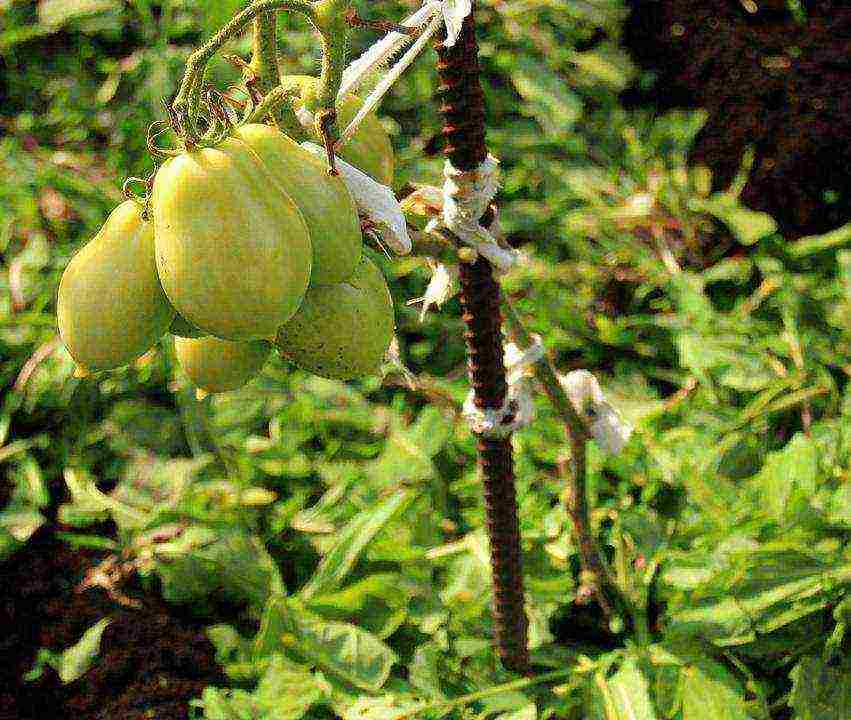
Grass mulching
Hilling is a controversial procedure. Some experts argue that hilling is absolutely necessary, others say that it is unnecessary and even harmful. Based on our own experience, we can confidently say that you can get a good harvest with or without hilling.
To understand whether it is necessary to huddle tomato bushes, you need to figure out why it is generally needed. The meaning of hilling is simple - it allows the tomato to grow additional roots. For example, if hilling is carried out after the appearance of the lower stepsons, the stems of these stepsons will give their own roots and will grow almost like separate plants, which will allow you to get more full-fledged bushes (and therefore harvest) with the same amount of seedlings. Hilling tomatoes of low-growing varieties makes the plants more resistant, which allows you not to waste time and effort tying them up. Otherwise, if the seedlings are planted deep enough, the root system will be developed enough not to huddle.
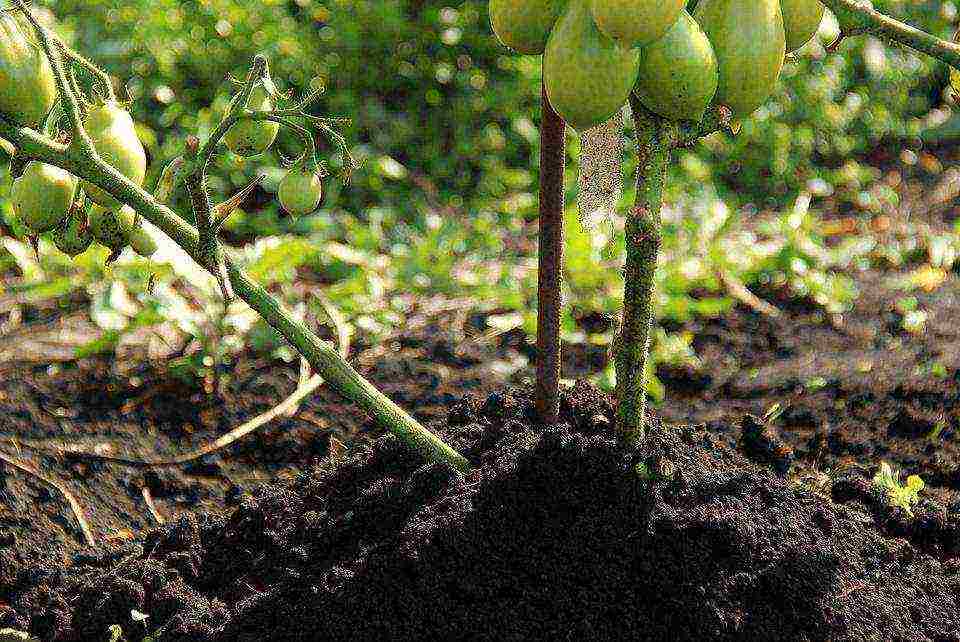
Hilling stepson
Plant formation
To accelerate the ripening of fruits and increase the yield, the tomato bush must be formed. Formation includes leaf removal, pinching, ovary thinning and pinching.For novice gardeners, formation, especially pinching, raises many questions, which we will answer in detail in the second part of the article.

Bunches of tomatoes
This year I decided to try myself as a gardener and grow tomatoes. I seem to have figured out the sowing of seeds - the seedlings have sprung up and are already flaunting on the windowsill, waiting for their time to move to the garden. Tell me, what should be the further care of tomato seedlings after planting them in the ground?
A good tomato harvest depends not only on strong seedlings. Timely measures for the care of young plants also play an important role. Indeed, with a lack of moisture or nutrition, tomatoes can not only get sick, but even die.
Caring for tomato seedlings after planting in the ground includes:
- watering;
- loosening the soil;
- hilling seedlings;
- mulching;
- fertilization of plants;
- the formation of tomatoes.
Watering after planting and during the growth of bushes
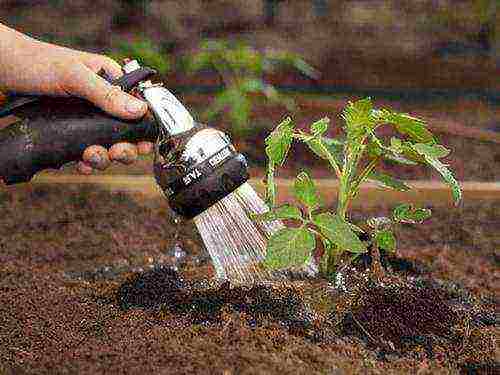
When transplanting seedlings into open ground, the holes are watered abundantly, so the next 1.5-2 weeks the plants do not need additional moisture, they are quite enough for them.
In the future, you should only keep the soil under the bushes in a moist state, watering it as it dries up until the beginning of fruit setting. But from this point on, tomatoes require more frequent watering so that the soil constantly has the same moisture content. Its drops can provoke the onset of diseases, a stop in the growth of green fruits, or a violation of the integrity of the shell of ripe tomatoes.
It is necessary to water the tomatoes in the evening, directing the water strictly to the root. Plants get sick from drops on the leaves.
Loosening and hilling
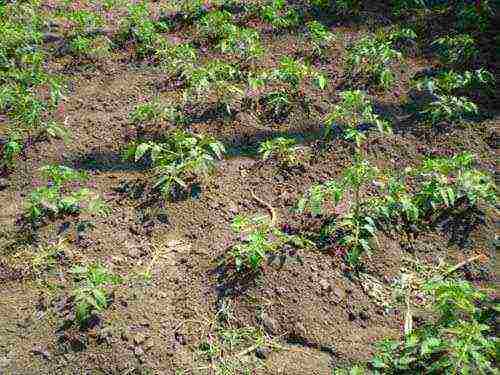
To provide air access to the root system after each watering, be sure to loosen the soil around the bushes, while removing weeds. In this case, the loosening depth is:
- up to 12 cm - at the first loosening;
- up to 5 cm - with the further implementation of the procedure.
Hilling bushes is necessary when adventitious roots appear on the main stem. This process improves the development of the entire root system, enriches the soil with oxygen and helps to retain moisture after watering.
During the season, tomatoes are recommended to spud at least 2 times.
Mulching row spacings
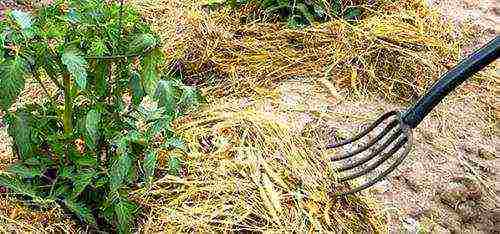
Laying mulch in the space between the rows of planted tomatoes will reduce the amount of watering and will bring the ripening of the tomato closer. As mulch, you can use green manure, rotted sawdust, straw or peat. Mulch prevents not only the rapid evaporation of moisture, but also the emergence and reproduction of weeds.
Top dressing tomato

To provide plants with nutrients, 4 additional fertilizing should be carried out:
- the first - 21 days after transplanting seedlings to the garden;
- the second - when blooming the 2nd flower brush;
- the third - when blooming the 3rd brush;
- the fourth - 14 days after the previous feeding.
As a fertilizer for tomatoes, it is good to use infusion of bird droppings, Bordeaux mixture, wood ash, urea, superphosphate.
Plant formation
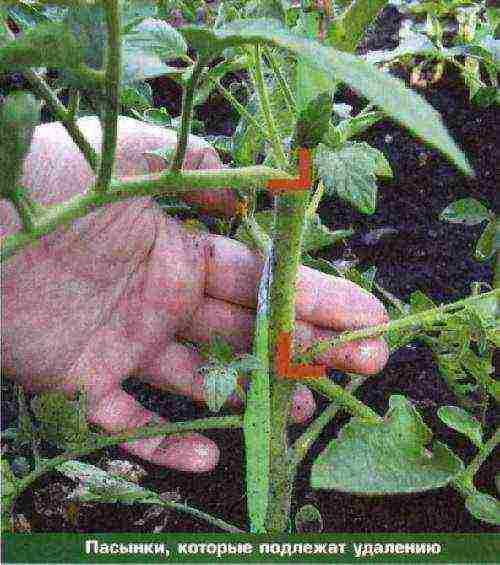
Most tomatoes need pinching or pinching, especially tall and large-fruited varieties. This contributes to the growth of fruits and accelerates their ripening. You can form a bush in 1, 2 or 3 stems. After pinching, at least 5 brushes with fruits and 30 leaves should be left on the plant.
The first care for tomatoes in the open field - video
.
Growing tomatoes for delicious fruits is not difficult for experienced gardeners. Ignorance of the peculiarities of development and the requirements of culture always provokes the appearance of diseases or deterioration of quality characteristics. In a quick overview, we'll show you how to grow tomatoes outdoors to get a high yield.

Variety of tomato varieties
reference Information
Tomatoes are a flowering plant from the nightshade family, which is commonly grown in agriculture as an annual.The homeland of the culture is the humid warm climate of Latin America. In Europe, tomatoes first appeared in the 16th century as a decorative element, but soon became an indispensable component of many national dishes.
The plant has a highly developed root system in the form of a rod. This structure allows the crop to extract nutrients and water from the soil. With increased moisture, roots form on any part of the stem that comes into contact with the ground. Therefore, tomatoes are propagated not only by seeds, but also by cuttings.
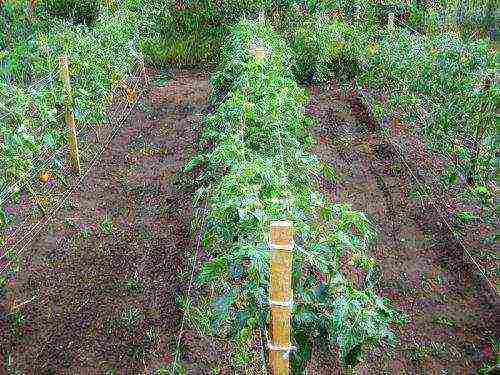
Tomatoes give excellent yields both in the greenhouse and in the open field
In the conditions of the domestic climate, it is recommended to grow tomatoes by seedlings.
A tropical plant is demanding for light and warmth. The optimum temperature for development is from +20 degrees. When it gets colder, pollen stops forming, and the tomatoes will shed their buds.

Planting temperature of tomatoes - air about +20, soil 12-15 degrees
Lack of solar energy will affect the appearance of the crop and the ability to hold ovaries.
Landing
Growing tomatoes in the open field begins with the selection of a site. In order for the culture to develop well and not get sick, they give preference to a sunny place.
You cannot plant seedlings along fences or tall trees, as the shade will negatively affect the quality of the fruit and the timing of ripening.
Tomatoes are involved in crop rotation, so the correct selection of predecessor plants is important. Recommended crops:
- cucumbers;
- cabbage;
- turnip;
- beet;
- onion.
Closely related plants have the same diseases and pests, and this will negatively affect the health and productivity of tomatoes.
Remember: Prohibited crops are all types of nightshade:
- potato;
- tomatoes;
- pepper;
- eggplant.
It is recommended to prepare the site in advance. Experienced gardeners dig up a place for tomatoes in the fall. Humus or phosphorus-potassium fertilizers are added to the soil. As a last resort, a handful of wood ash and 50 g of any complex preparation are poured into each hole.
When are tomatoes planted outdoors?
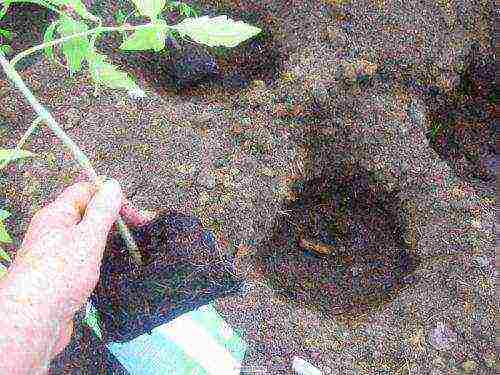
Planting tomato seedlings in prepared soil
The seedlings will die at the very first night frosts, so they need to be adjusted depending on the climatic features of the region:
- southern regions - at the end of April;
- middle band - mid-May;
- in the northern regions - early or mid June.
Holes for tomato seedlings are dug 5 cm deeper than a peat pot. The plants are carefully sprinkled with earth and watered with warm liquid. Experienced farmers immediately mulch the soil with sawdust at the base of the roots. The procedure will improve air circulation and facilitate further care.
Watering
Water is the basis for the life of tomatoes, but novice gardeners misunderstand the requirements of plants, so they flood the culture. Before the irrigation procedures, the clod of earth necessarily dries out. It is recommended to water infrequently, but abundantly. In moderate weather and no rainfall, the plantation is moistened once a week.
"For undersized young bushes, 2-3 liters will be enough, while watering adult giants will require at least 10 liters."
How to properly irrigate tomatoes outdoors? The procedure is carried out in the morning or in the evening so that there are no sudden changes in temperature. The stream of water is gently brought to the base of the plants, avoiding exposing the roots. Experienced farmers dig out special grooves through which moisture enters the bushes without loss.
Remember: the soil should not be allowed to dry out during the flowering of the culture. A mistake in leaving will lead to dropping of buds and a decrease in yield.
It is recommended to water the plantation in advance, but avoid stagnation of water at the roots. Sprinklers are prohibited, as they knock the ovaries. Before irrigation, the soil is loosened and weeds are removed.
Top dressing
Caring for tomatoes includes fertilizing. Tomato roots seek nutrients at depths of up to 2.5 m.In different periods of development, plants need different feeding.
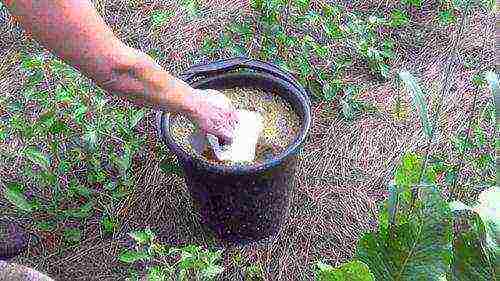
Liquid top dressing from herbal infusion and yeast
- Seedling. To build up green mass and roots, nitrogen-containing fertilizers are applied.
- Bloom. Magnesium and boron are needed to keep the buds from falling off. Spraying on the sheet is recommended.
- Fruit ripening. Phosphorus and potassium accelerate the reddening of tomatoes.
Remember: you cannot overuse fertilizers. An excess of trace elements is dangerous due to the accumulation of nitrates in tomatoes, which will negatively affect human health.
An overfed bush increases its green mass to the detriment of flowering and fruit formation. Stopping the application and thinning the foliage will help to correct the situation.
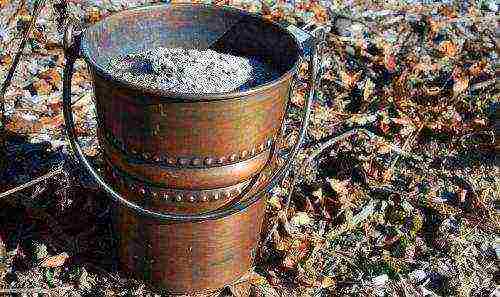
Ash is an excellent phosphorus-potassium fertilizer
How to fertilize tomatoes correctly? Before the procedure, the bushes are thoroughly irrigated with warm liquid so that chemicals do not burn the roots. The dressing solution is carefully poured under the base of the tomato.
Remember: during the growing season, you cannot add humus more than three times. It is recommended to alternate organic and industrial fertilizers.
After planting seedlings, agrarians carry out two mandatory feeding - in early June and in early July. From the middle of summer, fertilizers are stopped. Chlorine-containing preparations are prohibited, as they negatively affect the quality of the fruit and the health of the consumer.
What else is worth remembering
Caring for tomatoes isn't just about watering or fertilizing. Tall tomatoes are tied up after the seedlings are planted in open ground. Plants are fixed on pegs with wire or temporary trellises are erected. The culture does not come into contact with the soil, which protects against diseases. Increasing the aeration of the fruit improves the palatability.

Tying tomatoes to pegs will protect them from disease.
You cannot plant different varieties of plants in the same garden bed, as cross-pollination will lead to unpredictable results. It is recommended to lightly shake the stem of the tomato to improve the flow of pollen into the flowers. The procedure is carried out in the morning 2-3 times a week.
The formation of bushes allows you to get a rich harvest with modest varietal characteristics.
One stem is recommended for large-fruited crops to speed up maturation in northern regions. Two- and three-stem plants ripen longer, but they delight gardeners with an abundance of small tomatoes.
Not all varieties need to be pinned - to remove the processes from the axils of the branches. There are varieties that do not allow additional shoots. How to carry out the procedure correctly?
Stepsonizing tomatoes - you need to remove the stepson from No. 3
Gently break off or cut off with a knife the offspring, not allowing it to reach 2 cm. Activities are carried out every week after sunset.
"If in summer there are prolonged rains with a cold snap, it is advisable not only to pinch the tomatoes, but also to remove parts of the shoots and all the lower leaves from them, so that the bushes warm up faster and better ventilate."
Depending on the variety and region of growth, the first crop is harvested in mid or late July.
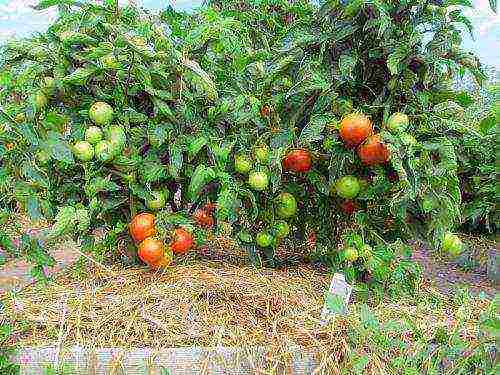
Mulching tomatoes conserves moisture in the soil
Remember: do not water the plants before harvesting.
Excess moisture will negatively affect the keeping quality of tomatoes. In autumn, when the temperature drops to +7 degrees, it is recommended to completely harvest the tomatoes, as the risk of diseases increases.
The largest, healthy fruits are advised to be left to obtain planting material. The seeds of the hybrids cannot be used for sowing the next year. The characteristics of the second generation are unpredictable, so it's not even worth trying.
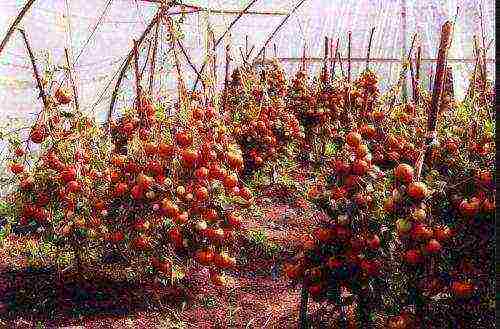
Good harvest of tomatoes in the greenhouse
Experienced farmers propagate rare species by cuttings. For this, strong, healthy branches are cut from the bushes and rooted in a pot. In the spring, the plant is cut into seedlings.
We figured out how to care for tomatoes outdoors. Our recommendations will help you grow a healthy crop and get a high yield without any problems.An excess or lack of attention is dangerous for tomatoes, which will lead to the death of plants.
Subscribe Be aware of new products on our site
